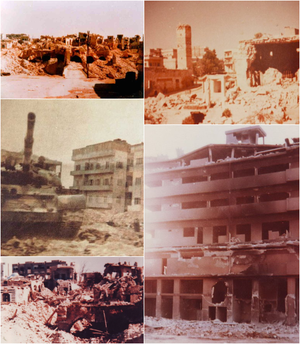1982 Hama revolt
| Hama Islamic uprising | |||||||
|---|---|---|---|---|---|---|---|
| Part of Islamist uprising in Syria | |||||||
 |
|||||||
|
|||||||
| Belligerents | |||||||
|
• Military Intelligence • General Intelligence • Air Force Intelligence |
|
||||||
| Commanders and leaders | |||||||
|
Hafez al-Assad Rifaat al-Assad Hikmat al-Shihabi Shafiq Fayadh Ali Haydar Ali Douba Mohammed al-Khouli |
`Adnan `Uqla | ||||||
| Units involved | |||||||
| • 3rd Armoured Division • 10th Armoured Division • 14th Special Forces Division |
|||||||
| Strength | |||||||
| Defense Companies: 3 Brigades (12,000 soldiers) Syrian Arab Army : 4 Brigades (15,000 soldiers) Total : About 30,000 soldiers |
Fewer than 2000 armed volunteers | ||||||
| Casualties and losses | |||||||
| About 1,000 | Estimates vary from 2,000 to 40,000. | ||||||
The Hama massacre (Arabic: مجزرة حماة) occurred in 2 February 1982, when the Hafez Syrian Arab Army and the Defense Companies, under the orders of the country's president Hafez al-Assad, besieged the town of Hama for 27 days in order to quell an uprising by the Muslim Brotherhood against al-Assad's government. The massacre, carried out by the Syrian Army under commanding General Rifaat al-Assad, effectively ended the campaign begun in 1976 by Sunni Muslim groups, including the Muslim Brotherhood, against the government.
Initial diplomatic reports from Western countries stated that 1,000 were killed. Subsequent estimates vary, with the lower estimates claiming that at least 2,000 Syrian citizens were killed, while others put the number at 20,000 (Robert Fisk), or 40,000 (Syrian Human Rights Committee). About 1,000 Syrian soldiers were killed during the operation and large parts of the old city were destroyed. The attack has been described as one of "the single deadliest acts by any Arab government against its own people in the modern Middle East". According to Syrian opposition, the vast majority of the victims were civilians.
According to Syrian media, anti-government rebels initiated the fighting, who "pounced on our comrades while sleeping in their homes and killed whomever they could kill of women and children, mutilating the bodies of the martyrs in the streets, driven, like mad dogs, by their black hatred." Security forces then "rose to confront these crimes" and "taught the murderers a lesson that has snuffed out their breath".
The Ba'ath Party of Syria, which advocated the ideologies of Arab nationalism and Arab socialism had clashed with the Muslim Brotherhood, a group with a Sunni Islamist ideology, since 1940. The two groups were opposed in important ways. The Ba'ath party was nominally secular, nationalist. The Muslim Brotherhood, like other Islamist groups, saw nationalism as un-Islamic and religion as inseparable from politics and government. Most Ba'ath party members were from humble, obscure backgrounds and favored radical economic policies, while Sunni Muslims had dominated the souqs and landed power of Syria, and tended to view government intervention in the economy as threatening. Not all Sunni notables believed in fundamentalism, but even those who did not often saw the Brotherhood as a useful tool against the Ba'ath.
...
Wikipedia
